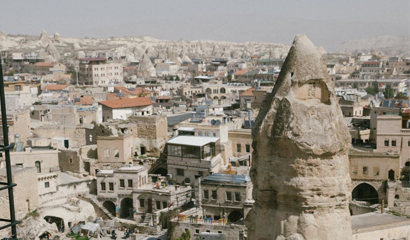Information About The History Of Cappadocia.

Cappadocia is a major tourist destination in Turkey and around the world. It is known for its unique rock formations, including the iconic fairy chimneys. These chimneys were formed by volcanic eruptions and erosion over millions of years.
The name "Cappadocia" comes from the Persian word Katpaktukya, which means "land of beautiful horses." To this day, locals offer transportation by horse, which is a great way to explore the region.
In addition to its natural beauty, Cappadocia is also home to a rich history and culture. The region was once inhabited by the Hittites, Romans, and Byzantines, and it contains many ancient ruins and churches.
Here is a brief overview of Cappadocia's history:
Early Civilizations: Cappadocia's history is intertwined with various ancient civilizations. It was home to the Hittites, who established their capital in the region during the 17th century BCE. The Hittites left behind a legacy of intricate rock carvings and inscriptions that can still be admired today.
Hellenistic and Roman Influence: Following the decline of the Hittite Empire, Cappadocia became a prominent part of the Hellenistic and later Roman Empire. The region flourished under Roman rule, with towns and cities carved into the unique geological formations known as fairy chimneys.
Christianity's Rise: One of the most significant chapters in Cappadocia's history is its transformation into a major center of Christianity. During the early Christian period, Cappadocia became a refuge for religious communities escaping persecution. The otherworldly rock formations provided natural hideaways for monks, who created incredible underground cities and churches, adorned with stunning frescoes.
Cappadocian Fathers: Cappadocia is also renowned for its early Christian theologians and scholars known as the Cappadocian Fathers, including Basil the Great, Gregory of Nyssa, and Gregory of Nazianzus. Their theological works significantly influenced the development of Christian doctrine.
Seljuk and Ottoman Eras: Over the centuries, Cappadocia experienced various invasions and changes in rule. During the medieval period, it was under the rule of the Seljuk Turks and later the Ottoman Empire. This diverse history left its mark on the region's architecture and culture, blending elements from different civilizations.
Today, Cappadocia's rich history is palpable as you explore its ancient rock-cut churches, underground cities, and the timeless landscapes that have captivated travelers for centuries. The region's cultural heritage and geological wonders combine to create a truly unique and awe-inspiring destination for photographers and history enthusiasts alike.
Discover the fascinating history of Cappadocia through the lens of our camera and immerse yourself in the timeless beauty of this extraordinary land.


